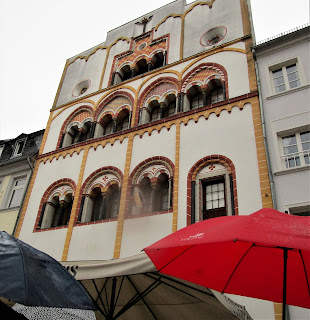It was time to leave the rivers for another overland bus trip. It did not take very long to get to Luxembourg. Our guide had to point out the spot on the highway where we crossed the border or we would never have known. Since the EU (European Union) it is not necessary to have customs offices at the borders, and you never have to show a passport when you travel from one EU country into another.

Our first stop was the American Cemetery. As you enter, the first thing you see is a tribute to the soldiers and a listing of the missing in action. Marks by some names mean that remains have been found and identified. Hundreds of soldiers who died in the Battle of the Bulge or shortly thereafter are buried here.

I never understood why it was called the Battle of the Bulge until I saw this map. It shows the troop movements and battles. The German troops had "bulged" into other countries.
Each grave is marked with a simple cross or Star, engraved on the back with name, Army unit, date of death and state. The rows are laid out in a semicircular manner around the Memorial Chapel.





One of the most famous soldiers in the cemetery is General Patton. His grave was originally in among the others, but so many people came to see it that they were destroying the grass all around the area. Now he is in a special area blocked off from the public. The only civilian buried here is his wife. Her ashes were buried near his grave.
 |
That is a bank in the background,
not a church. |
Luxembourg, the capital of Luxembourg, is the center of government and also of many corporations dealing with the European Union. When the EU was established, none of the more powerful countries wanted to have the headquarters in another powerful country, so tiny Luxembourg was chosen. This brought banks and other companies to the country. In years long ago, the churches were the tallest and most important buildings in a city. Here and now, it is the banks whose buildings rule the skyline. One exception is the column to victory. The Germans tore it down and tried to destroy it, but it resurfaced, in pieces after WWII. Part of the neck was missing, so now the statue looks down on the city instead of straight ahead.

The royal palace of the Duke of Luxembourg is adjacent to the legislature on a busy street. Although the royal family does not live there, the palace and its grounds are well guarded.


 |
| The emblem of Luxembourg |

The city has its share of churches too.

The old city sits on the top of the hills, with any attacker having to attack up-hill.


Colorful sculptures of brains dot the city. They will soon be auctioned off to raise money for charity.
From here, it is just a short ride to the French border, then a long ride to Paris.


















































